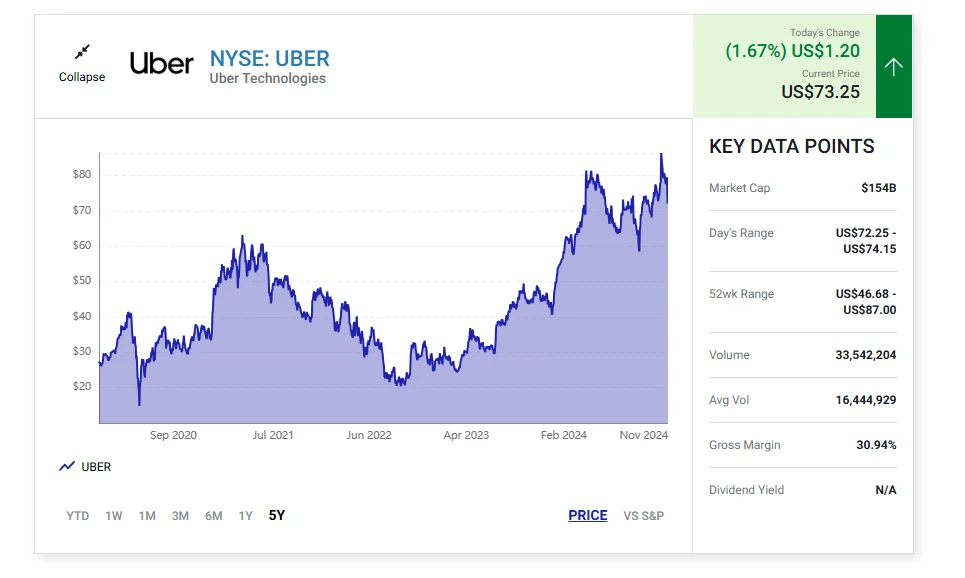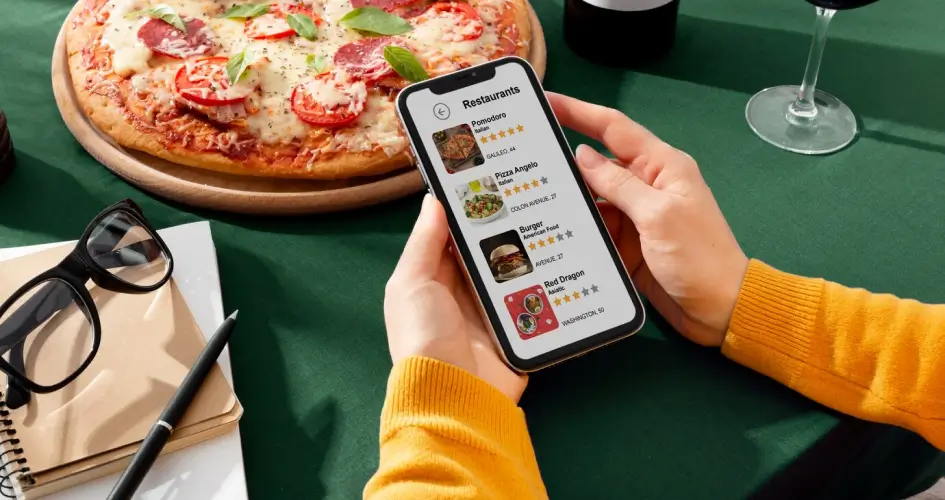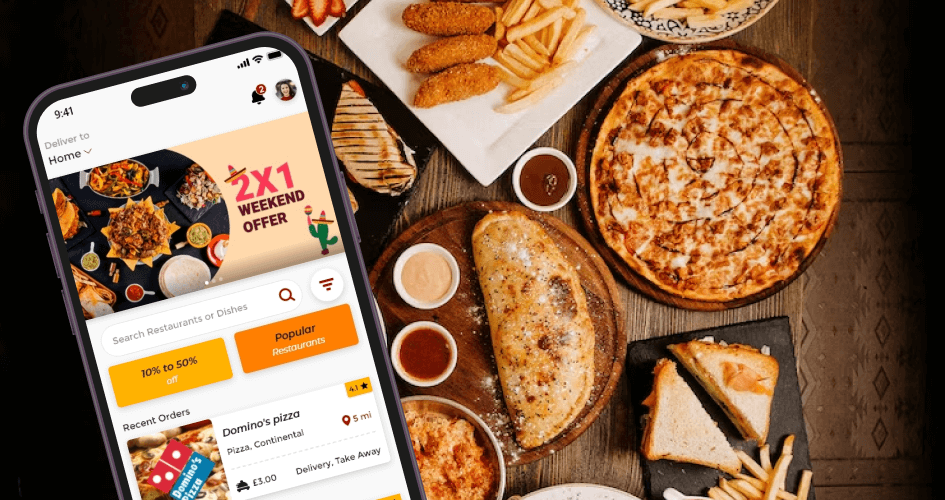Have you ever wondered how a simple craving transformed an entire industry?
Imagine this: in just a few years, a food delivery service not only disrupted the conventional dining experience but also altered the way we perceive convenience.
According to recent industry data, the food delivery market skyrocketed by 200% within the last five years, thanks to pioneers like Uber Eats.
Owned and operated by Uber Technologies Inc, Uber Eats stands at the forefront, driving this revolution.
With a breathtaking growth rate of over 50% annually, Uber Eats has become more than a mere food delivery app-it’s a transformative force.
Source: Fool.com
It’s more than just delivering meals.
Explore Uber Eats’ journey reshaping how we experience food and its huge impact on the food delivery business model.
How Uber Eats Redefined Food Delivery Services
Uber Eats emerged in 2014 as an extension of the renowned ride-sharing service, Uber.
It originated from a small-scale trial in Los Angeles, leveraging Uber’s existing infrastructure to cater to the rising demand for convenient meal delivery services.
Uber Eats’ platform revolutionized meal delivery with its user-friendly interface and real-time tracking, simplifying the entire ordering and delivery process.
Through strategic alliances with local eateries and a dual-sided marketplace model, Uber Eats swiftly penetrated global markets, offering a diverse range of cuisines while assisting restaurants in expanding their clientele.
Looking for best food delivery app development services to build your food ordering application?
Sign up for a FREE 30-minute consultation with experts at Intelivita now!
5 Ways Uber Eats Earns Revenue
Uber Eats follows various strategies to generate revenue, leveraging its innovative platform and expansive network.
Understanding how this food delivery giant earns its income provides insights into its business model:
1. Commission Fees
Uber Eats charges restaurants a commission fee for each order facilitated through its platform.
This fee typically ranges from 15% to 30% of the total order value, varying based on the restaurant’s agreement and services provided.
2. Delivery Fees
Customers often pay a delivery fee for the convenience of having their meals brought to their doorstep.
Uber Eats sets delivery fees that may fluctuate based on factors like distance, demand, or promotional offers.
3. Advertising Partnerships
Uber Eats collaborates with restaurants to promote their offerings through featured listings or advertisements within the app.
These promotional partnerships provide an additional revenue stream for Uber Eats.
4. Subscription Programs
The platform introduced subscription-based services like “Eats Pass,” offering benefits like free deliveries or discounts for a fixed monthly fee.
Subscriptions contribute to recurring revenue for Uber Eats.
5. Service Fees
Supplementary service fees, such as small order fees or busy area fees, occasionally apply to orders, adding to the overall revenue stream.
What are the Key Components of Uber Eats’ Business Model?
Uber Eats’ Multi-sided Platform Concept
Uber Eats functions as a pivotal link, bridging the gap between diners and restaurants, fostering a mutually beneficial relationship.
This platform empowers users to explore a myriad of dining options while allowing restaurants to expand their customer base organically, showcasing some of the top Uber Eats Features.
Exploring Uber Eats’ Technological Backbone Driving the Delivery Revolution
-
App Development and User Interface
The Uber Eats app redefines the user experience by offering personalized recommendations, intuitive navigation, and transparent tracking options, enhancing overall convenience.
-
Backend Operations and Logistics
A sophisticated backend system orchestrates seamless delivery operations, optimizing order management, logistics, and driver allocation, ensuring timely and reliable service.
How Has Uber Eats Grown and Expanded?
Curious about Uber Eats’ journey from inception to global dominance? Let’s explore its trajectory of growth and expansion.
Uber Eats, starting as a small-scale experiment, swiftly transcended borders, charting a path of exponential growth.
Let’s unveil how this delivery giant strategized its global expansion.
1. Uber Eats’ Dynamic Pricing Strategy
Uber Eats implements a dynamic pricing mechanism, adjusting prices in real-time to adapt to demand fluctuations.
This strategy allows Uber Eats to optimize revenue during peak hours and offer competitive pricing to attract customers during off-peak times.
2. Collaborative Restaurant Partnerships
Uber Eats fosters collaborative partnerships with restaurants through a revenue-sharing model.
This approach allows eateries to reach a broader audience and mutually share profits, establishing a win-win relationship.
Diversifying its partnerships allows Uber Eats to enrich its platform with a wide array of cuisines, catering to diverse consumer tastes.
This strategy enhances the platform’s appeal and enables it to capture a broader customer base.
3. Pioneering Global Expansion Strategy
Uber Eats’ journey across continents wasn’t accidental.
It was a meticulously planned strategy.
Here’s how they conquered the world map:
Localized Approach: Tailoring services to resonate with diverse cultural preferences.
Strategic Alliances: Collaborating with local businesses for rapid market penetration.
Tech Innovation: Enhancing the app interface for seamless user experiences globally.
Uber Eats vs. Competitors: A Comparative Glimpse
While DoorDash dominates the US, Grubhub boasts an extensive network.
Zomato and Talabat, focusing on global and regional markets respectively, add diverse competition to Uber Eats’ strategic landscape.
Uber Eats competes with industry giants, each with distinct strengths:
DoorDash – DoorDash Business Model, known for dominating the US food delivery market, owes its success to robust partnerships with a wide array of restaurants, solidifying its position as a top player.
Grubhub – Grubhub Business Model, boasting an extensive restaurant network, provides an abundance of dining choices.
With a strong urban presence across various US cities, it retains a loyal customer base.
Zomato – Zomato Business Model, with its global presence, offers a diverse range of cuisines across multiple countries, ensuring a rich culinary experience for its users.
Talabat – Talabat Business Model, dominating the Middle East region, focuses on localized services catering to local preferences, thereby ensuring exceptional user experiences.
Impact on the Food Delivery Industry
Changing Consumer Behavior
Uber Eats has revolutionized how people order food.
With just a few taps on their smartphones, consumers can access a wide variety of cuisines and have their meals delivered to their doorstep.
This convenience has led to a significant shift in consumer behavior, with more people opting for food delivery instead of dining out or cooking at home.
Influence on Traditional Delivery Services
Disruption of Conventional Models
Traditional delivery services have been significantly disrupted by the emergence of Uber Eats.
The traditional model of calling restaurants directly for delivery or relying on in-house delivery fleets has been challenged by Uber Eats’ technology-driven approach, which connects consumers with a network of restaurants and independent delivery drivers.
Effect on Local Businesses
Uber Eats has both positive and negative impacts on local businesses.
While it provides smaller restaurants with access to a larger customer base and increased visibility, it also poses challenges such as increased competition and commission fees.
Some local businesses have struggled to adapt to the digital marketplace created by Uber Eats, while others have thrived by leveraging its platform to reach new customers.
Challenges and Adaptations
Regulatory Hurdles
Uber Eats faces regulatory challenges in various regions related to labor laws, food safety regulations, and taxation.
These regulations vary from one jurisdiction to another, requiring Uber Eats to navigate a complex regulatory landscape to ensure compliance while maintaining operational efficiency.
Addressing Operational Challenges
Sustainability Concerns
One of the challenges faced by Uber Eats is addressing sustainability concerns related to food packaging and delivery emissions.
As the demand for food delivery grows, so does the environmental impact associated with packaging waste and transportation emissions.
Uber Eats is exploring initiatives such as eco-friendly packaging and electric delivery vehicles to mitigate its environmental footprint.
Customer Satisfaction and Retention
Maintaining high levels of customer satisfaction and retention is crucial for Uber Eats’ success.
Issues such as late deliveries, incorrect orders, and poor customer service can negatively impact the user experience and lead to customer churn.
Uber Eats continually invests in improving its platform, enhancing delivery tracking features, and providing responsive customer support to address these challenges.
Future Prospects and Innovations
Innovations in Delivery Technology
Uber Eats is investing in innovations in delivery technology to enhance efficiency and customer experience.
This includes leveraging artificial intelligence for route optimization, drone delivery trials for remote areas, and autonomous delivery vehicles for urban environments.
These technological advancements aim to make food delivery faster, safer, and more convenient for consumers.
Predictions for the Industry’s Future Landscape
Evolution of Delivery Services
The food delivery industry is expected to undergo further evolution, driven by changing consumer preferences and technological advancements.
Traditional delivery models may continue to be disrupted by digital platforms like Uber Eats, leading to increased consolidation and competition in the market.
Additionally, we may see the emergence of new delivery formats such as ghost kitchens and dark stores to meet the growing demand for convenience.
Potential Business Model Adjustments
As the food delivery landscape evolves, businesses like Uber Eats may need to make adjustments to their business models to remain competitive.
This could involve exploring alternative revenue streams, revising commission structures, or expanding into adjacent markets such as grocery delivery.
Flexibility and adaptability will be key for Uber Eats to stay ahead in an ever-changing industry landscape.
Frequently Asked Questions
How does Uber Eats differ from other food delivery platforms?
Uber Eats distinguishes itself through its extensive network of restaurants and delivery drivers, providing users with a wide variety of options.
Its seamless integration with the Uber app also sets it apart, offering users the convenience of accessing both ride-hailing and food delivery services in one place.
What strategies contributed to Uber Eats’ rapid growth?
Uber Eats’ rapid growth can be attributed to several key strategies, including aggressive market expansion, strategic partnerships with restaurants, effective marketing campaigns, and continuous investment in technology to improve the user experience.
How does Uber Eats manage logistical challenges?
Uber Eats manages logistical challenges through advanced algorithms that optimize delivery routes, efficient dispatching of drivers, and real-time tracking capabilities.
Additionally, Uber Eats collaborates closely with restaurant partners to streamline order processing and minimize delivery times.
What are the criticisms surrounding Uber Eats’ model?
Some criticisms surrounding Uber Eats’ model include concerns about commission fees charged to restaurants, potential exploitation of delivery drivers, and environmental impact due to packaging waste and emissions from delivery vehicles.
Additionally, there have been complaints about customer service issues and occasional inaccuracies in order fulfillment.
What could be the future innovations in the food delivery industry?
Future innovations in the food delivery industry may include advancements in delivery technology such as drone and autonomous vehicle delivery, enhanced sustainability practices to reduce environmental impact, and personalized recommendations based on user preferences and dietary restrictions.
Additionally, there may be increased integration of virtual kitchens and ghost kitchens to cater to evolving consumer preferences and market demands.
Wrapping Up!
In conclusion, Uber Eats has reshaped the food delivery industry with its innovative business model, driven by several key success factors:
- Convenience: Uber Eats offers unparalleled convenience to consumers, allowing them to order from a diverse range of restaurants with just a few taps on their smartphones.
- Accessibility: Uber Eats has made food delivery accessible to a wider audience, including those in remote or underserved areas.
- Scalability: The platform’s scalability allows it to adapt to changing consumer preferences and market dynamics, enabling rapid expansion into new markets and regions.
- Flexibility: Uber Eats provides flexibility to both consumers and restaurants, allowing them to choose from a variety of delivery options and customize their orders according to their preferences.
- Innovation: Constant innovation in delivery technology, sustainability initiatives, and customer experience enhancements positions Uber Eats at the forefront of the industry, driving continued growth and success.
Overall, Uber Eats’ success stems from its ability to effectively address the evolving needs of consumers and businesses alike, making it a dominant player in the competitive food delivery market.






